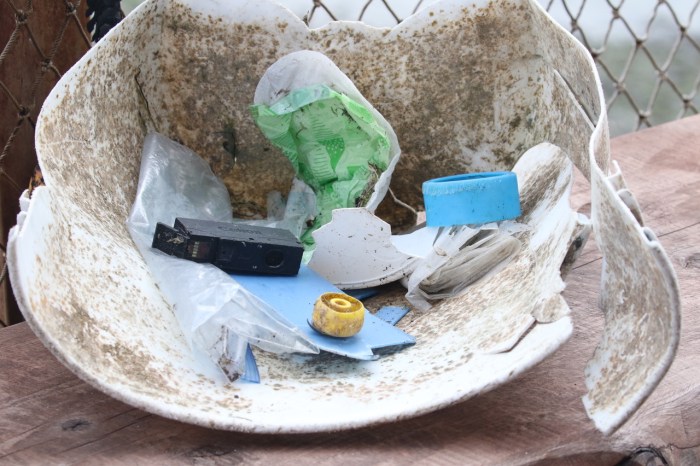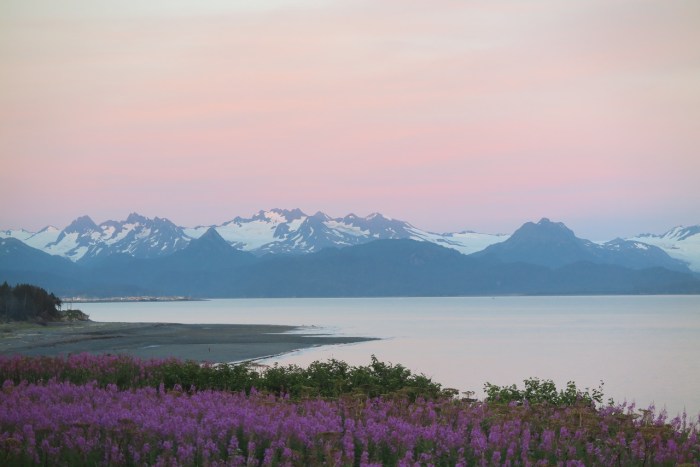
The Otter Whisperer
For the second year in a row, I have had close encounters with sea otters in Kachemak Bay, Alaska. The guides at the wilderness lodge have named me The Otter Whisperer.
The sight of me gliding close by in a kayak, holding a lens half as long as my arm, should have been disturbing to these endangered animals. But for some reason, the mothers showed me their babies, and one otter went to great lengths to groom himself in front of me, floating so close to the kayak I could have touched him. Others simply mugged for the camera, while one particularly old gentleman otter showed me his broken tooth and how he cleans it.
I saw my first-ever Otter Taxi: a band of 50 sea otters, some of which caught “rides” on other otters as they moved across the waters of a cove. And make no mistake: that otter tail is so powerful, they can cut through the water with the speed of otter-sized motorboats.
One guide said, “I’ve grown up here and never been so close to any sea otter as when you are in the kayak with me. They usually dive deep to stay away from humans.”
I don’t think I possess any special otter juju, but I do think a lifetime spent with horses and dogs has taught me how to be respectful and non-threatening — how to be sensitive and appreciative of their essence, be it horse, dog, cat, chicken, or otter.
Endangered species
In Kachemak Bay, there are approximately 5,000 sea otters. Hunted to near extinction in the 19th century, the species was first protected with the signing of the International Fur Seal Treaty in 1911, and later in the 1970s under the Endangered Species and Marine Mammal Protection Act.
Worldwide, there used to be sea otter populations of more than a million before the fur trade decimated their numbers. Today there are approximately 106,000 sea otters in the world.
Otters are the heaviest members of the weasel family. They do not have blubber to keep them warm; instead, sea otters are insulated by the densest fur in the animal kingdom, ranging from 250,000 to a million hairs per square inch.
Sea otters are critical to the ocean environment. They help maintain the balance of near-shore kelp ecosystems. Without sea otters, the undersea animals they eat such as urchins, mussels, clams, and crabs, would devour the kelp forests. Kelp also plays an important role in capturing carbon in coastal ecosystems.
Because kelp grows from the bottom of the sea floor to the surface, otters will wrap themselves in ribbons of it to keep themselves from drifting in strong currents.
Male otters can live 10-15 years, while females live 15-20 years. The Northern Sea Otters who make their home in Alaskan waters can weigh as much as 100 pounds.
Threats to sea otters include shark attacks, more frequent now that sea otters are expanding their range in search of food. Conflict with humans, often in the form of entrapment in fishing nets, poses a major threat to sea otter populations. Land pollution that runs off into the ocean contaminates the sea otters’ habitat, jeopardizing their food sources. Scientists have reported the accumulation in sea otters of man-made chemicals such as PCBs and PBDEs — polybrominated diphenyl ethers, which are flame retardants used in furniture and electronics — in some of the highest levels ever seen in marine mammals.
What do sea otters have to do with horses?
Both are part of the intricate web of ocean and land. Grazing animals are as important to grasses and open land as sea otters are to kelp forests and bays. The food both species eat needs to be free of man-made contaminants. A study presented at the Salish Sea Ecosystem Conference (April 2018) analyzed the Puget Sound food eaten by captive sea otters at the Seattle Aquarium and showed that the mussels had high glyphosate and PBDE values and surf clams had high amounts of pyrethroids, commonly used in popular insecticides.
A crowd-funded study compiled by the Ramazzini Institute in Italy along with Bologna University, the Italian National Health Institute, George Washington State University, and the Icahn School of Medicine observed the health effects of glyphosate on Sprague Dawley rats, which had been dosed with the US EPA-determined safe limit of 1.75 micrograms-per-kilo of body weight. The authors reported that glyphosate can have disrupting effects on sexual development, genes and beneficial gut bacteria, even at doses considered safe. The study is published in Environmental Health, May, 2018.
Of course horses aren’t rats, yet they are continually exposed to herbicides like Roundup in their hay, pastures, and in feeds containing non-organic ingredients such as beet pulp, alfalfa, soy, wheat, flax, oats, peas, canola, and sunflower seeds.
Fortunately the bio-resin shilajit (an important ingredient in BioStar’s Impulsion EQ and Quantum EQ for horses, and Juvenate K9 for dogs) is beneficial in blocking glyphosate-related cellular damage, and closing the tight junctions in the gut. This helps to reduce the GI tract effects of glyphosate and other herbicides.
Cause and effect
The fact that climate change has become a political hot button distracts from the real issue: that the environmental impacts of a changing climate are real and they are here, now.
Scientists at the Gulf of Maine Research Institute observed that, over the past 30 years, the waters in Maine have warmed at a rate three times the global average. Higher temperatures in the cold Maine waters affect lobsters and whales. Federal wildlife officials in Alaska are documenting a die-off of Alaskan seabirds from the Bering Strait to the Gulf of Alaska that they think is connected to a trend of warming ocean water, which is affecting the birds’ food supply of fish. The seabirds are dying of starvation.
Will we lose the sea otters too?
Plastics
We produce 300 million tons of plastic per year. More than eight million tons are dumped into our oceans, or carried by rivers, floods, and runoff from landfills. More than 500 billion plastic bags are used worldwide, and more than 1 million bags are used every minute. In the last ten years, we have produced more plastic than during the whole of the last century. Worldwide, only 9% of plastic is recycled.
According to National Geographic: “Plastic takes more than 400 years to degrade. Seventy-nine percent of plastics are accumulating in landfills, or as litter… If present trends continue, by 2050 there will be 12 billion metric tons of plastic in landfills. That amount is 35,000 times as heavy as the Empire State Building.”
According to the World Economic Forum, “In 1974, the average per-capita plastic consumption was 2 kg. Today this has increased to 43 kg per person.”
If we reduce our use of plastic straws, plastic bags, single-use plastic items including cups, plates, and cutlery we can start to reduce the amount of plastic in the landfills and the ocean. There are some wonderful and simple alternatives: plates, utensils and cups made from bamboo and pressed leaves; reusable glass coffee cups with heat protectors we can use at Starbucks; glass and metal straws; reusable shopping bags.
Flip-flops
Flip-flops are worn by over three billion people, and the lifespan of these plastic thongs is approximately two years. Ninety tons of flip-flops wash up on the East African coast, mostly from India, China, and Kenya.
A group of artists in Kenya is creatively countering some of the problem by harvesting the flip-flops that wash up onto beaches, and crafting some striking, memorable animal sculptures out of them.
Turn, Turn, Turn
Pete Seeger’s song of changes written in the late 1950s and immortalized by the Byrds in 1965 has an important resonance in 2018: “A time to build up, a time to break down; a time to dance, a time to mourn; a time to cast away stones, a time to gather stones together.”
The animals we share our lives with — be they domesticated, or the wild creatures we only glimpse from time to time or see in photos and videos — are depending on us to repair that which we have damaged… in essence, to gather stones together. To stop laying waste to ocean and land. To be whisperers for all life on the planet.
There is a season, and the season is now.
Photos by Tigger Montague
















That is a beautiful story Tigger. I am so pleased to purchase from a company that sees life as it now is…endangered. And also has products I appreciate feeding to my horse. Will now look into your dog products.
Sincerely,
Doris
Beautiful commentary. Thank you.
BTW: Wind turbines are destroying millions of birds, bats, animal habitats, and not a comment about how much fossil fuels go into making these turbines, not a comment about how each “wing” of a turbine weights TONS alone and how delivering these turbine parts to their new home requires millions of fuel to ship, remake roads and environments to carry the tonnage required. Also, wind turbines are typically put in areas of wind updrafts – and millions of migrating birds, eagles, geese, bats, sparrows, butterflies, etc. are destroyed because they use the same wind updrafts. Not to even mention that wind turbines still require local coal fired electricity plants to keep making the electricity that wind turbines do not produce b/c winds are not able to be “controlled”. Sometimes wind turbines are run by electricity to show the public that they are actually “working”. And… wind turbines have a life time of maybe 30 years and each one is buried in thousands of tons of concrete (which in itself is a pollutant) and when that turbine dies, it will remain there forever. Animals hate the buzz of turbines. Our government in the US (and other countries) have allowed companies who produce wind turbines to not worry about the birds and animals these turbines kill – but are granted a moratorium for 30 years (this in the last administration) and to “govern” themselves. It is a fact that the bury the thousands of dead birds each month so that no one knows.
Just asking… yes, your article about plastics is very correct, but wind turbines are just as bad.